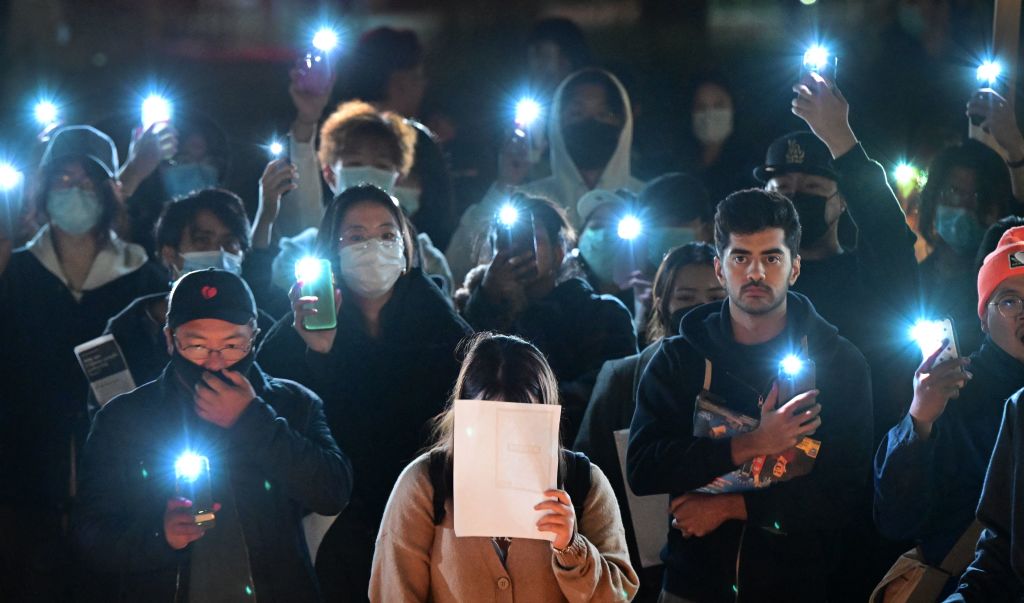
As protests against Xi Jinping’s Zero-COVID policy spread across China’s diverse cities and regions over the last week, one symbol remained constant: a blank sheet of paper.
On a bridge in Beijing, dozens of protesters held sheets of blank paper aloft, as gridlocked cars below contributed toward a cacophony of horns—described in captions on social media, where several videos of the event went viral, as expressions of support.
And on a road in Shanghai that has become a symbolic center of the protest movement, police attempted to disperse hundreds of protesters on Sunday—some of whom were holding blank sheets of paper, Reuters reported.
China’s first major protests in years began last week as an expression of dissent against China’s strict zero-COVID policy, which has left the country oscillating through cycles of lockdowns even as much of the rest of the world returns to a semblance of normality. The spark appeared to be a fire in a tower block in the city of Urumqi, in the northwest Xinjiang region, which killed 10 people. The victims are rumored to have been unable to escape due to a strict COVID lockdown in which people were locked into their apartments, although the Chinese government denies this.
The protests are the most sustained since the student protest movement of 1989 that was brutally suppressed when security forces massacred students at Tiananmen Square in Beijing, leaving hundreds or even thousands dead. Under President Xi, protests have become increasingly rare in China. His rule has been marked by an uptick in forms of social control like AI-enhanced surveillance and heavy police crackdowns on dissent.
But already, the protests that began as dissent against Xi’s zero-COVID policy appear to be morphing, at least for some, into a wider protest against authoritarianism. In Shanghai, a man holding a flower at a gathering of protesters was arrested by police after he questioned other arrests and referred to the fire in Urumqi. “We must be brave,” the man could be heard telling the crowd in videos shared on social media, before being bundled into a vehicle.
The blank sheet of paper has become so pervasive that, online, people have begun referring to the protests in China as the “A4 revolution”—a reference to the standard paper size used in printers—or “white paper revolution.” Many observers have described the paper as a representation of everything protesters wish they could say but cannot. It presents authorities with a difficult conundrum: arrest people for saying literally nothing at all or allow a simple act of resistance to proliferate unchallenged. In the social media age, the blank sheet has the added benefit of being difficult for online censors to quickly block at scale without accidentally censoring many other innocuous images or videos.
Read More: Zero-COVID Protests in China Have Rattled Global Markets
A global symbol against censorship
The A4 sheet of paper has a longer history as a symbol of protest globally. Protesters in Hong Kong held up blank sheets of paper in 2020 in protest against the restrictive National Security Law that increased Beijing’s power over the semi-autonomous enclave. In Russia earlier this year, protesters opposing the Kremlin’s invasion of Ukraine were arrested for holding up blank sheets of paper amid a government crackdown on dissent. Those arrests only sparked further outrage online. The tactic was echoed by protesters in the U.K. demonstrating against a new draft law partially restricting the right to protest, drawing comparisons between the U.K. and more authoritarian states like Russia.
The blank sheet of paper also confounds online censors in places like China and Russia, where online discussion is restricted. In China, where online censorship is especially sophisticated, social media platforms like WeChat, Weibo, and Douyin use a combination of human reviewers and AI to remove videos of protests. Access to the global internet beyond China’s “great firewall,” where information about the protests is spreading more freely, is blocked. But by adopting previously benign items as their symbols, protesters reduce the applicability of AI systems, which can take engineers long amounts of time to adjust to reliably detect new symbols. Human censors must work overtime to fill the gap by removing photos and videos—meaning there’s a greater chance of some content slipping through and inspiring others.
But like any potent form of political symbolism, the A4 sheet of paper might obscure as much as it reveals. “The demonstrators have broad slogans,” tweeted Nathan Law, an activist who played a leading role in the 2019-2020 protest movement in Hong Kong, who is now living in self-imposed exile in London. Political opinion in China is varied, with many protesters clearly upset at zero-COVID policies but not necessarily the government as a whole. “A blank sheet of paper with various expressions is unavoidable in this movement,” Law wrote in a follow-up tweet. “Because the conditions for broad mass consensus … do not exist.”
— With additional reporting by Man Sum Lai.
More Must-Reads From TIME
- The 100 Most Influential People of 2024
- The Revolution of Yulia Navalnaya
- 6 Compliments That Land Every Time
- What's the Deal With the Bitcoin Halving?
- If You're Dating Right Now , You're Brave: Column
- The AI That Could Heal a Divided Internet
- Fallout Is a Brilliant Model for the Future of Video Game Adaptations
- Want Weekly Recs on What to Watch, Read, and More? Sign Up for Worth Your Time
Write to Billy Perrigo at billy.perrigo@time.com